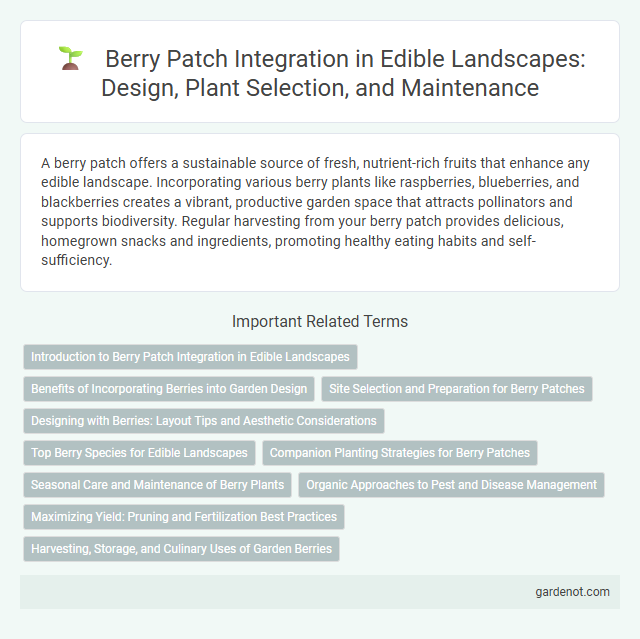A berry patch offers a sustainable source of fresh, nutrient-rich fruits that enhance any edible landscape. Incorporating various berry plants like raspberries, blueberries, and blackberries creates a vibrant, productive garden space that attracts pollinators and supports biodiversity. Regular harvesting from your berry patch provides delicious, homegrown snacks and ingredients, promoting healthy eating habits and self-sufficiency.
Introduction to Berry Patch Integration in Edible Landscapes
Berry patch integration in edible landscapes enhances biodiversity and provides a sustainable source of fresh fruit throughout the growing season. Incorporating a variety of berries such as strawberries, raspberries, and blueberries maximizes yield while optimizing soil health and pollinator activity. Strategic placement of berry patches within edible landscapes supports ecological balance and creates an aesthetically pleasing, functional garden space.
Benefits of Incorporating Berries into Garden Design
Incorporating berries into garden design enhances both aesthetic appeal and ecological value, offering vibrant foliage and seasonal fruit that attract pollinators and wildlife. Berry patches provide a sustainable source of fresh, nutrient-rich produce rich in antioxidants, vitamins, and fiber, supporting health and wellness. Integrating species like blueberries, raspberries, and blackberries promotes soil health through natural nitrogen fixation and reduces reliance on chemical fertilizers.
Site Selection and Preparation for Berry Patches
Selecting a site with well-drained, loamy soil and full sun exposure is crucial for establishing a productive berry patch. Prepare the soil by testing pH levels, aiming for a range between 5.5 and 6.5, and incorporating organic matter such as compost to enhance fertility and moisture retention. Proper site preparation minimizes disease risk and promotes robust root development for berry crops like blueberries, raspberries, and blackberries.
Designing with Berries: Layout Tips and Aesthetic Considerations
Designing a berry patch involves strategic layout planning to maximize sunlight exposure and ease of harvest, ensuring optimal growth and fruit production. Incorporate a variety of berry species such as blueberries, raspberries, and strawberries to create visual interest through diverse foliage colors and seasonal fruiting patterns. Utilize natural borders like low hedges or pathways to enhance accessibility and aesthetic appeal while maintaining plant health and productivity.
Top Berry Species for Edible Landscapes
Top berry species for edible landscapes include strawberries, blueberries, raspberries, and blackberries, valued for their high yield and nutritional benefits. Blueberries thrive in acidic soils and provide antioxidants, while raspberries and blackberries offer rich flavor and adaptability across climates. Strawberry plants are ideal for ground cover, enhancing soil health while producing abundant, sweet fruit for landscape integration.
Companion Planting Strategies for Berry Patches
Companion planting in berry patches enhances growth by pairing strawberries with garlic or onions to deter pests naturally. Blueberries benefit from planting with legumes like clover, which enrich soil nitrogen and improve berry yield. Mulching with aromatic herbs such as lavender or thyme helps retain moisture and attracts pollinators vital for fruit production.
Seasonal Care and Maintenance of Berry Plants
Berry plants require regular pruning after harvesting to promote healthy growth and maximize future yields. Mulching around the base helps retain moisture and control weeds during dry seasons. Monitoring for pests and diseases throughout the year ensures early intervention, maintaining plant vigor and berry quality.
Organic Approaches to Pest and Disease Management
Berry patches thrive with organic approaches to pest and disease management that prioritize natural predators such as ladybugs and lacewings to control aphids and other harmful insects. Incorporating disease-resistant berry cultivars and maintaining proper spacing ensures enhanced air circulation, reducing fungal infections like powdery mildew and botrytis. Applying organic neem oil and compost tea further strengthens plant immunity while minimizing chemical residues, promoting a healthy, sustainable edible landscape.
Maximizing Yield: Pruning and Fertilization Best Practices
Pruning berry patches during the dormant season enhances sunlight penetration and air circulation, leading to increased fruit production and reduced disease risk. Applying balanced fertilizers with essential nutrients such as nitrogen, phosphorus, and potassium promotes vigorous growth and higher yields. Implementing these best practices ensures optimal berry quality and maximizes overall patch productivity.
Harvesting, Storage, and Culinary Uses of Garden Berries
Garden berries such as raspberries, blackberries, and blueberries are best harvested when fully ripe and slightly soft, ensuring peak sweetness and flavor. Store berries in shallow containers in the refrigerator to prevent crushing and prolong freshness for up to a week. These versatile berries enhance salads, desserts, jams, and sauces, offering rich nutritional benefits including antioxidants, vitamins C and K, and dietary fiber.
Berry patch Infographic

 gardenot.com
gardenot.com